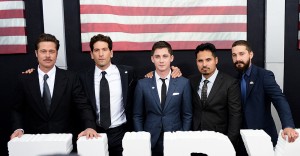You can usually judge a director’s filmmaking prowess by their ability to make a war movie. It’s not easy to depict the horrors of battle convincingly. Once in a while, someone captures that electrifying realism, creating a masterpiece that becomes stitched into the very fabric of pop culture. Steven Spielberg had “Saving Private Ryan,” Stanley Kubrick had “Full Metal Jacket,” and now David Ayer has “Fury.”

Released Oct. 17, “Fury” is the newest World War II flick on the block. Luckily, Ayer knows what he’s doing, giving us a gritty film. The writer-director has credits on “Training Day” and “End of Watch,” proving himself capable of well-researched dialogue and engaging characters. His latest effort hits the perfect combination of tried-and-true war genre themes: violence, brotherhood, loss and sacrifice. While working with a model of platitudes, the director gives us a glimpse into something we’ve never seen before: a deeper look into the Second Armored Division.
Brad Pitt is back, but you won’t see him scalping Nazis here. His role of Sgt. Don “Wardaddy” Collier is much more grounded than Lt. Aldo Raine as American forces push further into Germany in April 1945. While Victory in Europe Day is only a month away, they find heavy resistance and superior tank power as Adolf Hitler mobilizes every man, woman and child into a total war.
Collier is the leader of an M4 Sherman tank whose inhabitants fit those personas you’d expect to find in a Hollywoodized WWII squad: the seasoned leader, the religious one who always quotes scripture, the brash one who is hard to control, the ethnic one and the rookie. Pitt, Shia LaBeouf, Jon Bernthal, Michael Pena and Logan Lerman fill these positions. All of them do a terrific job, nailing that sense of sibling-like camaraderie that comes from years of fighting in several different countries. It forces the audience to empathize with a bunch of average Joes who have seen their fair share of suffering. “Wait till you see it … what a man can do to another man,” deadpans LaBeouf’s Boyd “Bible” Swan.
Like Tom Hank’s Cpt. John Miller, Pitt’s scarred “Wardaddy” is a powerful presence, a guy who’s terrified of what he witnesses every day but knows he needs to keep moving forward. In the spirit of Jeremy Davies’ Cpl. Upham in “Saving Private Ryan,” Lerman’s Pvt. Norman Ellison is a simple typist who’s never killed in his life and temporarily questions the ethics of murder.
Unlike most movies in its class, “Fury” is not very morally compromised about the rights and wrongs of the conflict. It’s not in the Nazi-sympathizing business, it’s in the killing-Nazi business, and, cousin, business is booming. The movie lives up to its name, striking down Adolf’s boys with, the “great vengeance and furious anger” of Ezekiel 25:17. In short, you’ll feel more American pride after watching it.
The American tanks rumbling through enemy territory go by the names you’d expect giant robots to have in a “Pacific Rim” movie: Fury, Lucy Sue and Murder Inc. To the men who fight in them, the treaded machines act as home, protection and the occasional brothel that can mow down SS officers faster than you can say “fubar.” A clever shot of memorabilia inside the vehicle shows us they’ve been at it a long time.
Ayer’s greatest strength is his ability to occupy the worlds of levity and action without faltering. The tank battles are exhilarating and the more human moments show you just how all-encompassing war can be. A close-quartered scene in a small German town plays out like a one-act play of humor, tension and emotion. It makes you take a step back from the violence and see its effects on the human psyche and how it can creep into the most peaceful of places.
The movie’s filming location of Oxfordshire, England, serve as perfect double for a rain-soaked, war-torn countryside. Roman Vasyanov’s gritty cinematography is a close second to the desaturated, bleached look that Janusz Kaminski gave “Ryan” to resemble color newsreels of the 1940s. Sadly, Steven Price’s forgettable soundtrack pales in comparison to the patriotic hymns of John Williams, the sitar of the Rolling Stones’ “Paint it Black” or even Richard Wagner’s “Flight of the Valkyries” blaring from the speakers of a Huey helicopter.
”Fury” knows that war is hell while also aware of the human moments that cut through the gore and bloodshed. Movies about WWII and the Holocaust are so important because they’re a reminder that decent things can still be done in indecent times. It may evoke “Private Ryan” a little too eagerly for some, but it is the movie by which I selfishly judge all others. Yet, amidst the bullets and artillery, Ayer finds his own voice, crafts a graphic, mournful piece that joins the exclusive club of war films that try to derive meaning from nonsensical things. The takeaway this time is simple: we may think we love the smell of napalm in the morning, but it’s the bravery to do what’s right that we really crave.

